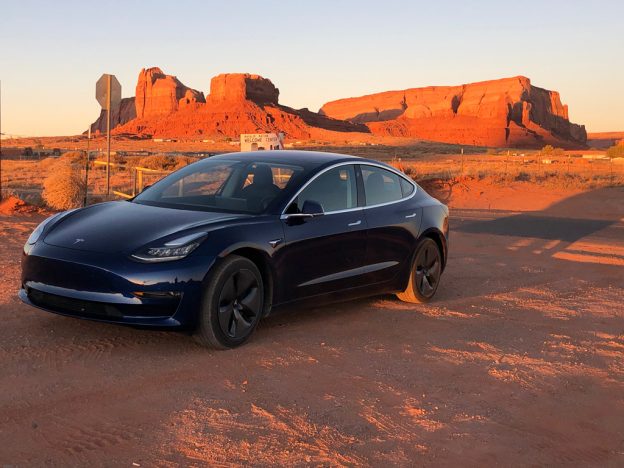December 2020. California and the American Southwest.
The driving range of electric cars on the market today can easily meet the daily driving needs for the average person. In my case I charge my Model 3 for about 2 hours every night in the garage for daily driving. But what about charging an electric car on longer drives and road trips?
In October 2019 I used Tesla’s Supercharging network on a 2700 mile road trip from California’s Central Valley out to Albuquerque and back. In this post I share data collected on that trip to address basic questions like: How far and how long do you drive between charging stops?; How long does it take to charge your EV on a road trip?; and How well does Supercharging work?
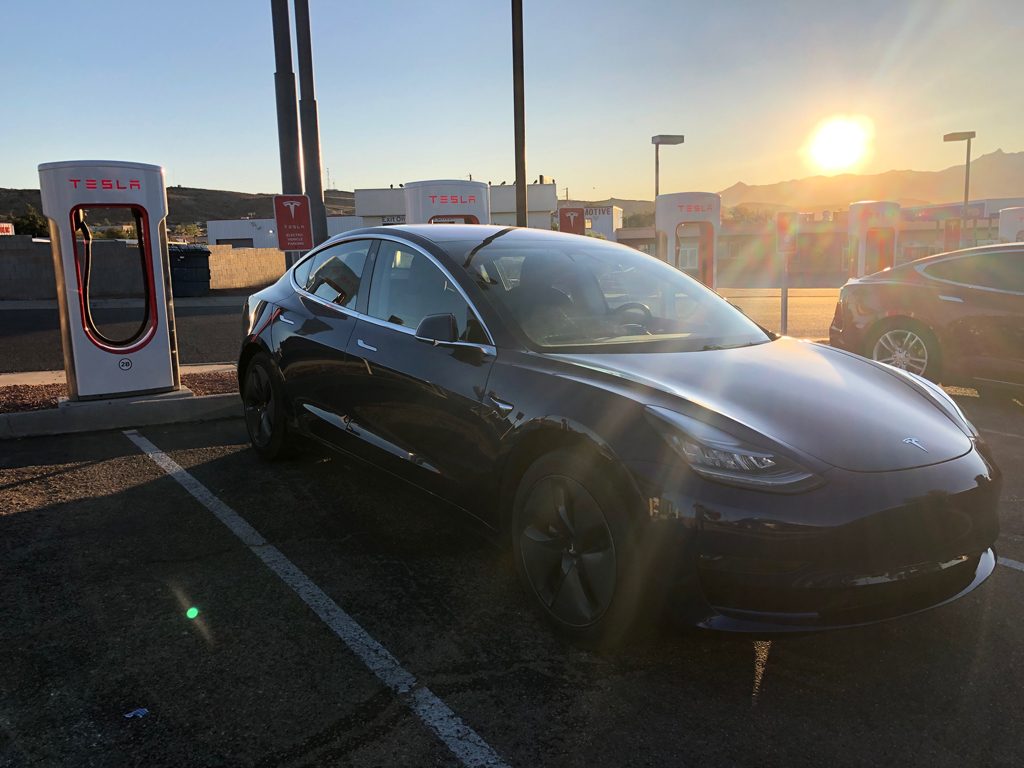
I saved the following data: (1) the range of the car at the start of each leg; (2) the number of miles driven and the driving time for each leg; (3) the range of the car when I arrived at a Supercharger or destination; (4) how long it took to charge; (5) how many miles of range were added to the pack; and (6) the range of the car after charging.
The trip odometer in the Model 3 records miles driven, driving time, kWh consumed, etc. So it was just a matter of remembering to take a pic of the odometer when I arrived at a charging stop, and noting battery pack range before and after charging:
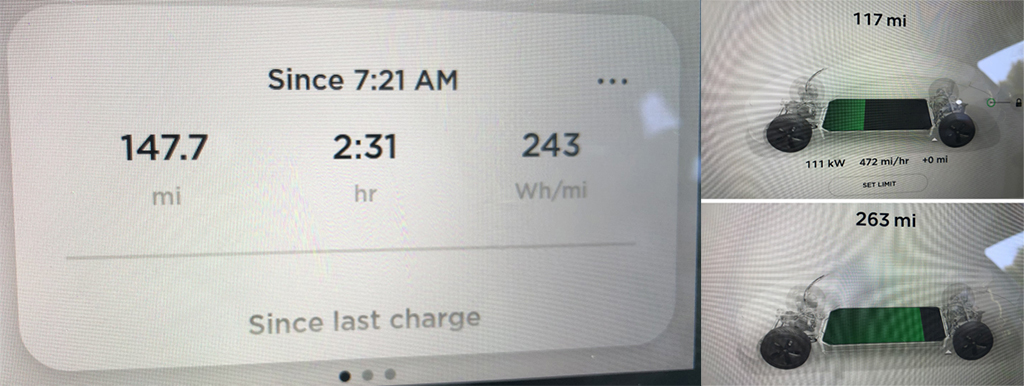
I took 3 days getting to Albuquerque and scheduled time for an afternoon hike in the Grand Canyon, and for stops at other sites like Meteor Crater. After several days of work in Albuquerque I drove home by way of Monument Valley. The full trip was 2,721 miles through 6 states. I stopped at 17 Superchargers and paid $92.66 for charging.
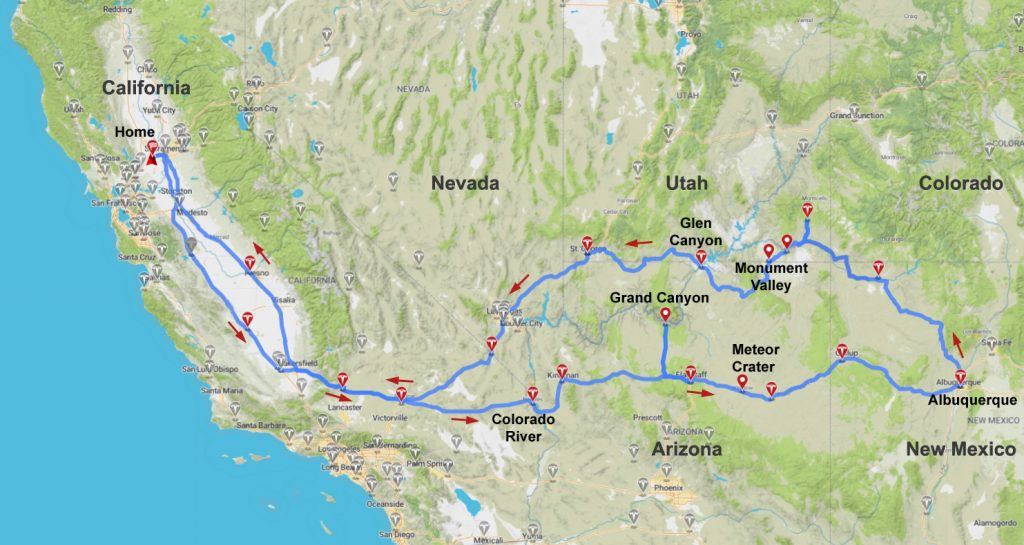
I’ve pasted a screen shot from an Excel chart below that highlights different aspects of the basic driving and charging data. The ‘Driving Stats’ columns show the starting range of the pack, miles and driving time for each leg, and range of the pack when I arrived at each stop. The ‘Charging Stats’ columns show the charging time for each leg, miles of range added to the pack, kWh delivered during the charge, range after charging, and cost. Miles driven per day is indicated on the left.
I did a full charge on my Level 2 charging station at home (240 Volts / 30 Amps) to start the trip, and used Level 2 stations in the Grand Canyon and Albuquerque – designated ‘L2′ in the chart below. I also used a 120 Volt outlet in Monument Valley – designated ‘L1‘. (Read up on L1, L2 and rapid DC charging here if you are not familiar with these terms). I didn’t need the L1 and L2 stations to complete the trip but they were available so I used them. I rarely went below a 30% SOC (~100 miles of range) during the trip: my lowest range was 81 miles when I arrived at the Mojave Supercharger on the last day.
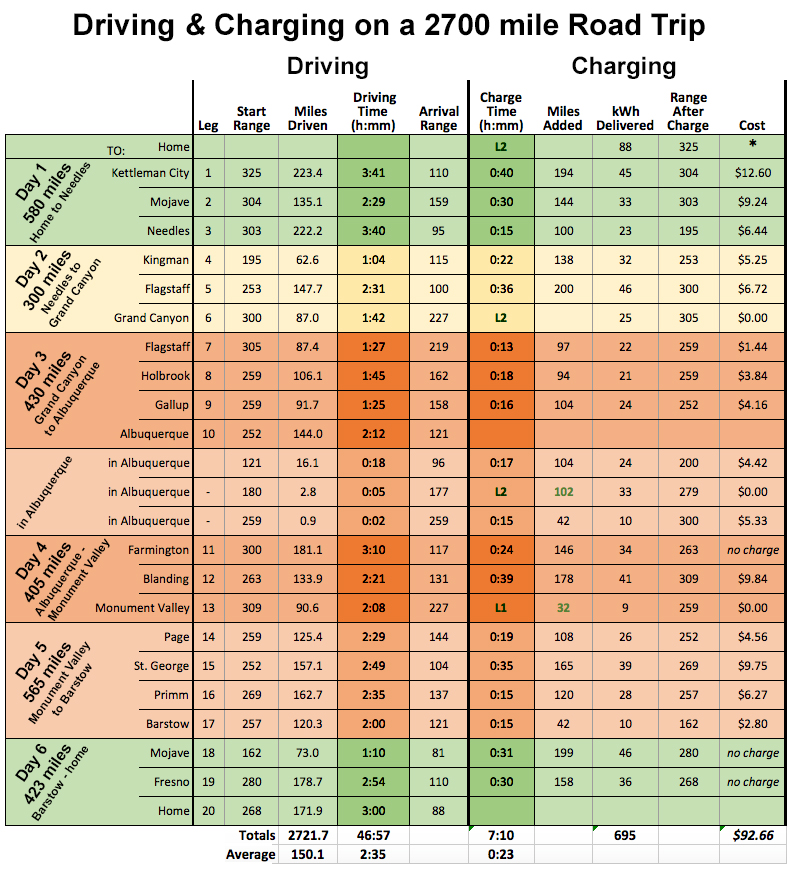
Driving Stats:
The average distance between supercharging stops was 150 miles (range 62 to 223 miles). Average driving time between Superchargers was 2 hours and 35 minutes, and the longest legs were 3 hours 40 minutes of driving.
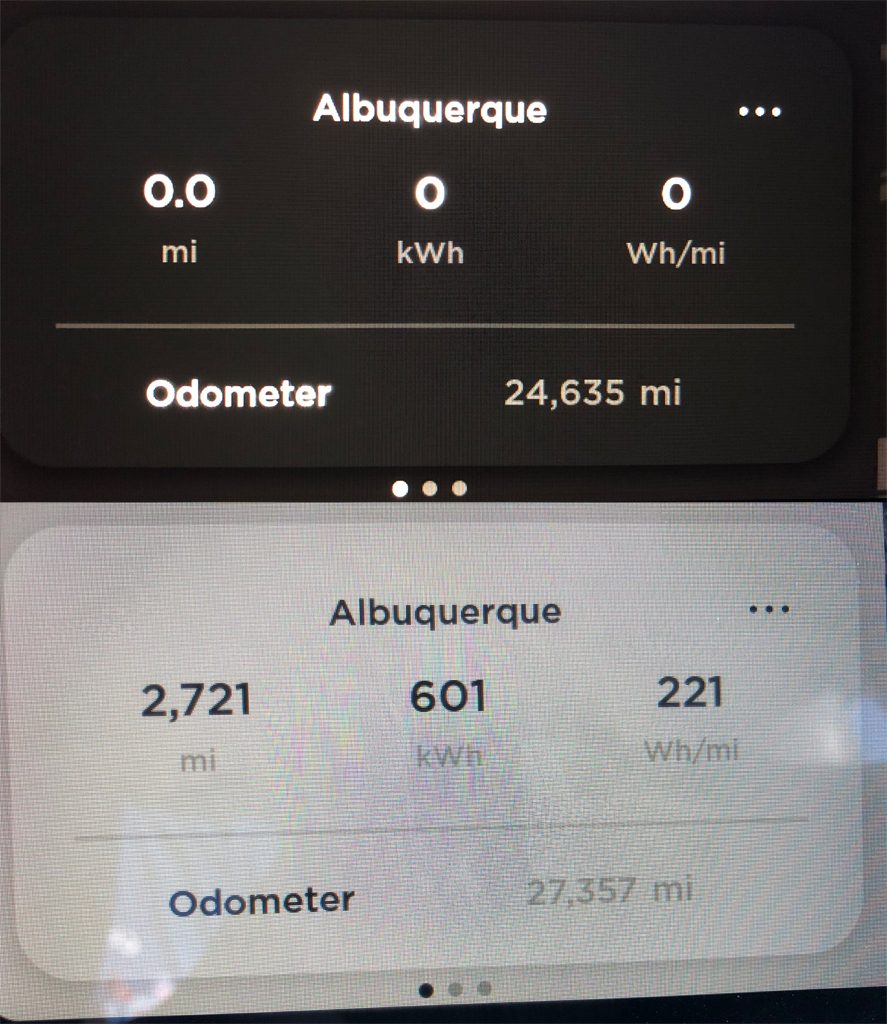
Note: I did not optimize the trip to have the lowest number of charging stops, or the quickest charging time – charging speed is faster when you arrive at a Supercharger with 20-30% SOC (less than 100 miles). I could have skipped some Superchargers, but stopped at places I wanted to see, and in some cases just to check out a location when I didn’t need a charge.
Charging Stats:
Average supercharging time was 23 minutes (range 13 to 40 minutes). The peak charging power I noticed was 148 kW. I did not use Tesla’s 250 kW V3 Superchargers. The most miles of range added to the pack in the shortest time was 199 miles in 31 minutes.
Another way to look at the data is to consider total driving and charging time. Total driving time on this trip was 47 hours, and total Supercharging time was 7 hours 10 minutes. That works out to about 30 minutes of charging for every 3 hours and 15 minutes of driving.
DC Charging Networks
The Tesla Supercharger network is very easy to use. To date Tesla has installed over 20,000 Superchargers at 2000+ locations. You park and plug in – no buttons to push, no fobs, cards, or phone app needed – the car and Supercharger take care of everything. I did not have to wait to charge at any of the Supercharger sites I used. One charger in Primm, NV didn’t work so I just moved over to the next stall and reported the problem. At each of the charging stops I ate lunch or a snack, bought some coffee, or just stretched my legs. Stopping every 2½ hours or so kept me fresh for the journey.

For those driving non-Tesla EVs the Electrify America network (shown below), the EVgo network, and other regional partners are rapidly building out a decent nationwide network. As examples, the Chevy Bolt EV and the new Ford Mach-E Mustang can tap into the Electrify America network. I spoke with a Ford rep who is driving a Mach-E around California to show the car at Ford dealerships. He shared data from one of his charging sessions on an Electrify America DC charger. The Mach-E accepted the full 150 kW power from the charger and took 33 minutes to deliver 43 kWh to the battery pack (based on EPA ratings that’s about 150 miles of range). This is similar to the amount of energy my Model 3 gets from a Supercharger in 30 minutes, and shows that other EVs can make these sorts of road trips using the growing DC charging network.
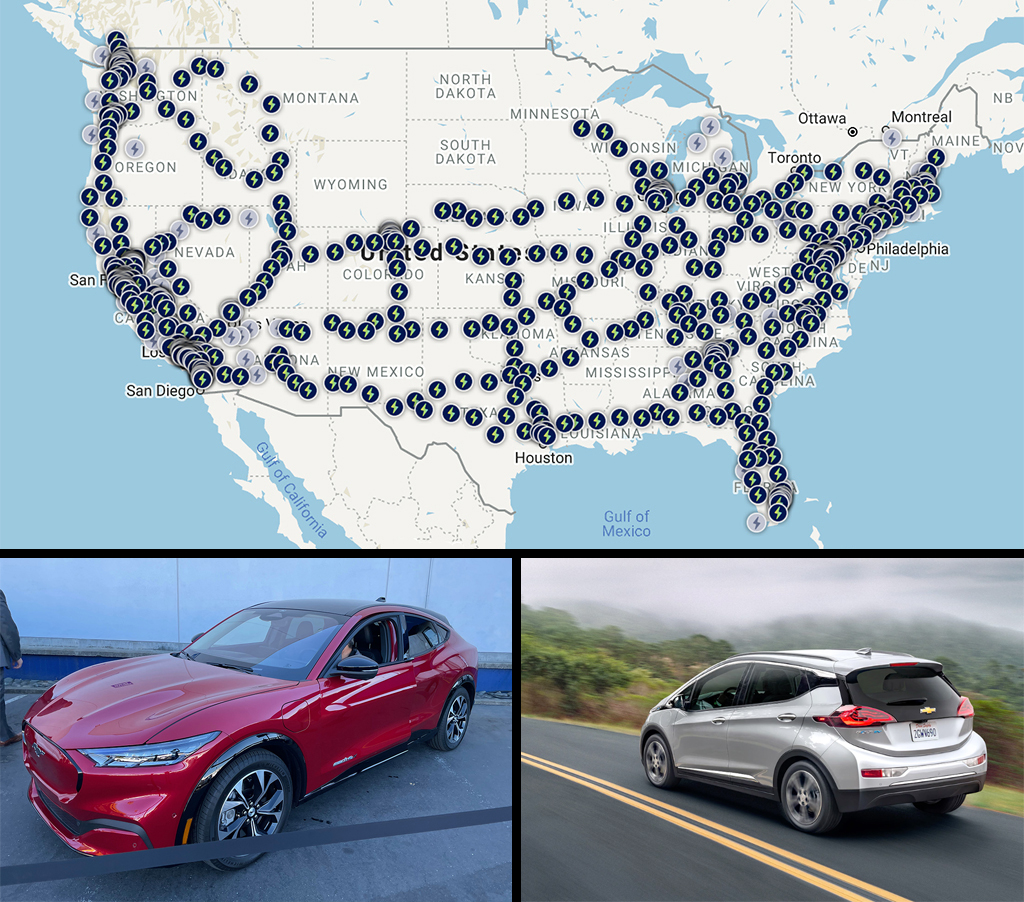
Tesla Superchargers, Electrify America, and EVgo charging stations are usually located along major highways in shopping plazas where you have good options for a bite to eat, coffee, grocery shopping, etc. And 30 minutes goes by a lot quicker than you might imagine. On my first electric road trip I timed how long it took to take care of essentials during charging stop. I plugged in and started a timer. Got a coffee, a sandwich, took a quick #1 break and when I got back to my car 22 minutes had elapsed. So, on an average stop, just taking a pitstop, getting food and drink alone takes almost as much time as you might need to charge. In addition, to me the benefits of driving electric far outweigh other considerations.
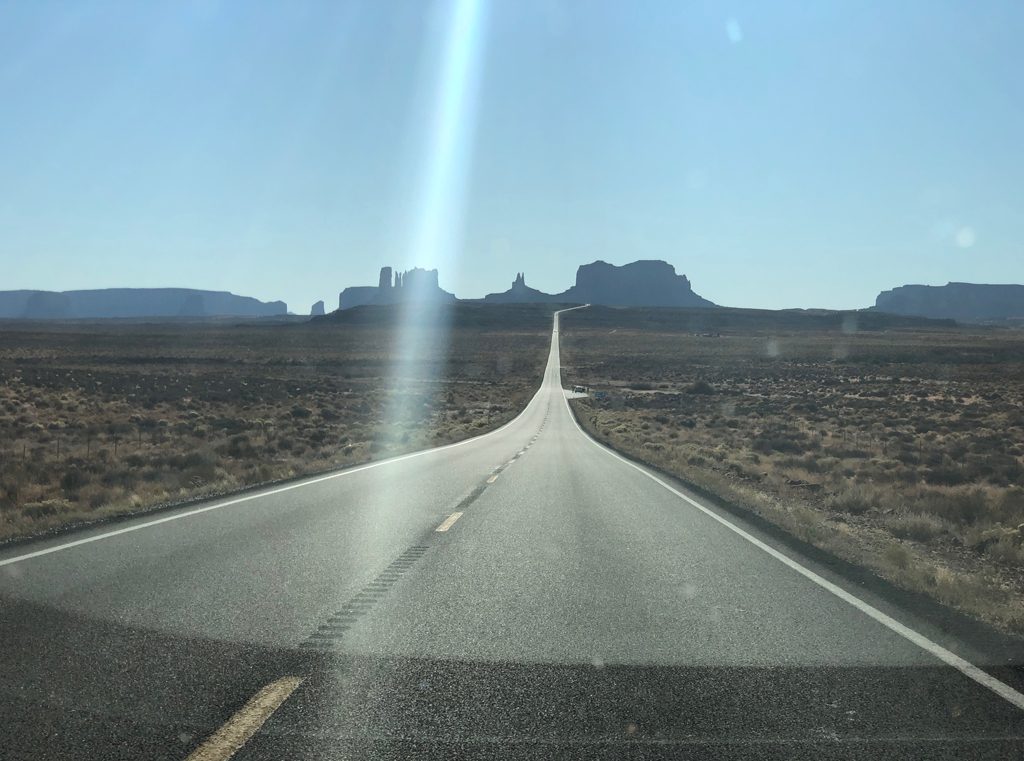
Stopping every 2½ hours for about 25 minutes kept me fresh for the journey, and made the trip safer and more enjoyable. Conclusion? DC charging works.
- For those interested, a longer post about this trip that includes analysis of carbon emissions and pics taken along the way can be found here.
- A new post on Supercharging data from a family trip to the Grand Canyon is here.

